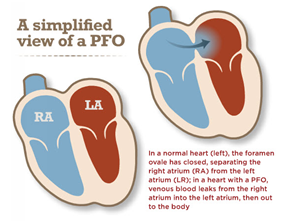A Patent Foramen Ovale (PFO) is a small hole between the left and right upper chambers of the heart. Everyone is born with this hole, but it typically closes on its own. A PFO exists when that hole doesn’t close naturally.
According to the
American Heart Association (AHA), about 25% of Americans have a PFO. Many people with a PFO never realize they have one and don’t have any associated health problems. For a small number of patients, a PFO can increase the risk of stroke, transient ischemic attack (TIA), and heart attack. According to the AHA, as many as half of patients who have had had a stroke of an unknown cause, or those who have had a stroke before age 55, have a PFO.
A hole in the heart in and of itself does not cause a stroke. Rather, the hole provides an opening for blood to flow be-tween the right and left side chambers of the heart. Problems can arise when a blood clot travels across the hole to the brain and causes a stroke.

Holes in the Heart
Learn more about PFO from the American Heart Association.